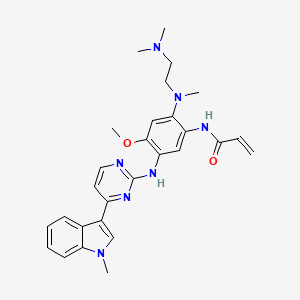


| Pair Name | Epigallocatechin gallate, Osimertinib | ||
| Phytochemical Name | Epigallocatechin gallate (PubChem CID: 65064 ) | ||
| Anticancer drug Name | Osimertinib (PubChem CID: 71496458 ) | ||
| Structure of Phytochemical |

|
Download
2D
MOL
3D
MOL
|
|
| Structure of Anticancer Drug |

|
Download
2D
MOL
3D
MOL
|
|
| Pair Name | Epigallocatechin gallate, Osimertinib | |||
| Disease Info | [ICD-11: 2C25.Z] | Lung cancer | Investigative | |
| Biological Phenomena | Inhibition-->Glycolysis | |||
| Gene Regulation | Up-regulation | Expression | ROS1 | hsa6098 |
| Up-regulation | Activity | PRKAA1 | hsa5562 | |
| Down-regulation | Phosphorylation | MAPK1 | hsa5594 | |
| Down-regulation | Phosphorylation | AKT1 | hsa207 | |
| Down-regulation | Phosphorylation | MTOR | hsa2475 | |
| In Vitro Model | NCI-H1975 | Gefitinib-resistant lung adenocarcinoma | Homo sapiens (Human) | N.A. |
| In Vivo Model | Human NCI-H1975 or AR cells were subcutaneously inoculated into the right flank of nude mice at a density of 2×10⁶ cells for H1975 and 5×10⁶ cells for AR, respectively. When the tumors grew to reach around 100 cm3 in volume, the animals were randomly divided into 6 groups with equal size (n = 5 mice per group) for treatment. | |||
| Result | The combined use of EGFR-TKIs and EGCG significantly reversed the Warburg effect by suppressing glycolysis while boosting mitochondrial respiration, which was accompanied by increased cellular ROS and decreased lactate secretion. The combination effectively activated the AMPK pathway while inhibited both ERK/MAPK and AKT/mTOR pathways, leading to cell cycle arrest and apoptosis, particularly in drug-resistant NSCLC cells. The in vivo results obtained from mouse tumor xenograft model confirmed that EGCG effectively overcame osimertinib resistance. | |||
| No. | Title | Href |
|---|---|---|
| 1 | Epigallocatechin gallate circumvents drug-induced resistance in non-small-cell lung cancer by modulating glucose metabolism and AMPK/AKT/MAPK axis. Phytother Res. 2023;37(12):5837-5853. doi:10.1002/ptr.7990 | Click |
